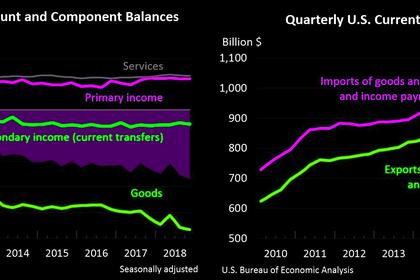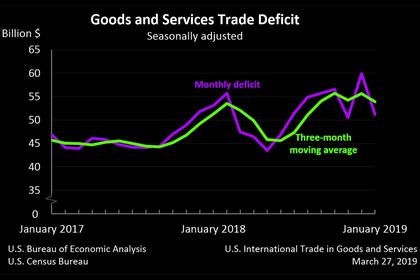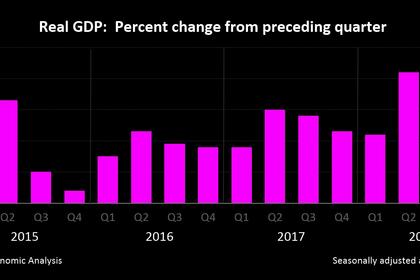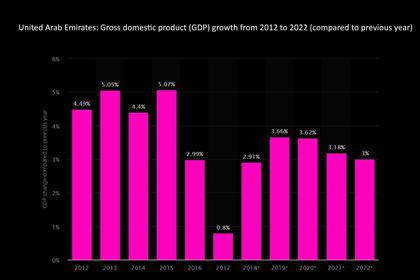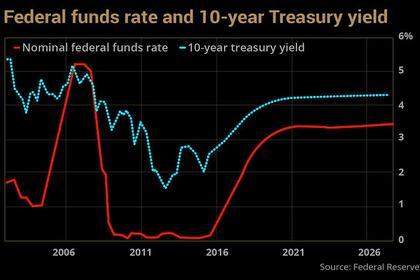
U.S. UNEMPLOYMENT 3.8%
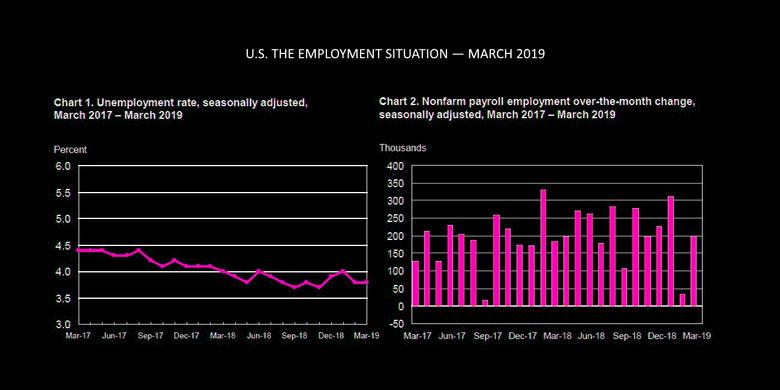
U.S. BLS - Total nonfarm payroll employment increased by 196,000 in March, and the unemployment rate was unchanged at 3.8 percent, the U.S. Bureau of Labor Statistics reported today. Notable job gains occurred in health care and in professional and technical services.
This news release presents statistics from two monthly surveys. The household survey measures labor force status, including unemployment, by demographic characteristics. The establishment survey measures nonfarm employment, hours, and earnings by industry. For more information about the concepts and statistical methodology used in these two surveys, see the Technical Note.
Household Survey Data
The unemployment rate remained at 3.8 percent in March, and the number of unemployed persons was essentially unchanged at 6.2 million.
Among the major worker groups, the unemployment rates for adult men (3.6 percent), adult women (3.3 percent), teenagers (12.8 percent), Whites (3.4 percent), Blacks (6.7 percent), Asians (3.1 percent), and Hispanics (4.7 percent) showed little or no change in March. (See tables A-1, A-2, and A-3.)
In March, the number of long-term unemployed (those jobless for 27 weeks or more) was essentially unchanged at 1.3 million and accounted for 21.1 percent of the unemployed.
The labor force participation rate, at 63.0 percent, was little changed over the month and has shown little movement on net over the past 12 months.
The employment-population ratio was 60.6 percent in March and has been either 60.6 percent or 60.7 percent since October 2018.
The number of persons employed part time for economic reasons (sometimes referred to as involuntary part-time workers) was little changed at 4.5 million in March. These individuals, who would have preferred full-time employment, were working part time because their hours had been reduced or they were unable to find full-time jobs.
In March, 1.4 million persons were marginally attached to the labor force, little different from a year earlier. (Data are not seasonally adjusted.)
These individuals were not in the labor force, wanted and were available for work, and had looked for a job sometime in the prior 12 months. They were not counted as unemployed because they had not searched for work in the 4 weeks preceding the survey.
Among the marginally attached, there were 412,000 discouraged workers in March, about unchanged from a year earlier. (Data are not seasonally adjusted.) Discouraged workers are persons not currently looking for work because they believe no jobs are available for them. The remaining 944,000 persons marginally attached to the labor force in March had not searched for work for reasons such as school attendance or family responsibilities.
Establishment Survey Data
Total nonfarm payroll employment increased by 196,000 in March, with notable gains in health care and in professional and technical services. Employment growth averaged 180,000 per month in the first quarter of 2019, compared with 223,000 per month in 2018.
Health care added 49,000 jobs in March and 398,000 over the past 12 months.
Over the month, employment increased in ambulatory health care services (+27,000), hospitals (+14,000), and nursing and residential care facilities (+9,000).
Employment in professional and technical services grew by 34,000 in March and 311,000 over the past 12 months. In March, computer systems design and related services added 12,000 jobs. Employment continued to trend up in architectural and engineering services (+6,000) and in management and technical consulting services (+6,000).
In March, employment in food services and drinking places continued its upward trend (+27,000), in line with its average monthly gain over the prior 12 months.
Employment in construction showed little change in March (+16,000) but has increased by 246,000 over the past 12 months.
Manufacturing employment changed little for the second month in a row (-6,000 in March, following +1,000 in February). In the 12 months prior to February, manufacturing had added an average of 22,000 jobs per month. Within the industry, employment in motor vehicles and parts declined in March (-6,000).
Employment in other major industries, including mining, wholesale trade, retail trade, transportation and warehousing, information, financial activities, and government, showed little change over the month.
The average workweek for all employees on private nonfarm payrolls increased by 0.1 hour to 34.5 hours in March, offsetting a decline of 0.1 hour in February. In manufacturing, the average workweek was unchanged in March at 40.7 hours, while overtime decreased by 0.1 hour to 3.4 hours. The average workweek for production and nonsupervisory employees on private nonfarm payrolls rose by 0.1 hour to 33.7 hours.
In March, average hourly earnings for all employees on private nonfarm payrolls rose by 4 cents to $27.70, following a 10-cent gain in February. Over the past 12 months, average hourly earnings have increased by 3.2 percent.
Average hourly earnings of private-sector production and nonsupervisory employees increased by 6 cents to $23.24 in March.
The change in total nonfarm payroll employment for January was revised up from +311,000 to +312,000, and the change for February was revised up from +20,000 to +33,000. With these revisions, employment gains in January and February combined were 14,000 more than previously reported. (Monthly revisions result from additional reports received from businesses and government agencies since the last published estimates and from the recalculation of seasonal factors.)
After revisions, job gains have averaged 180,000 per month over the last 3 months.
-----
Earlier:
